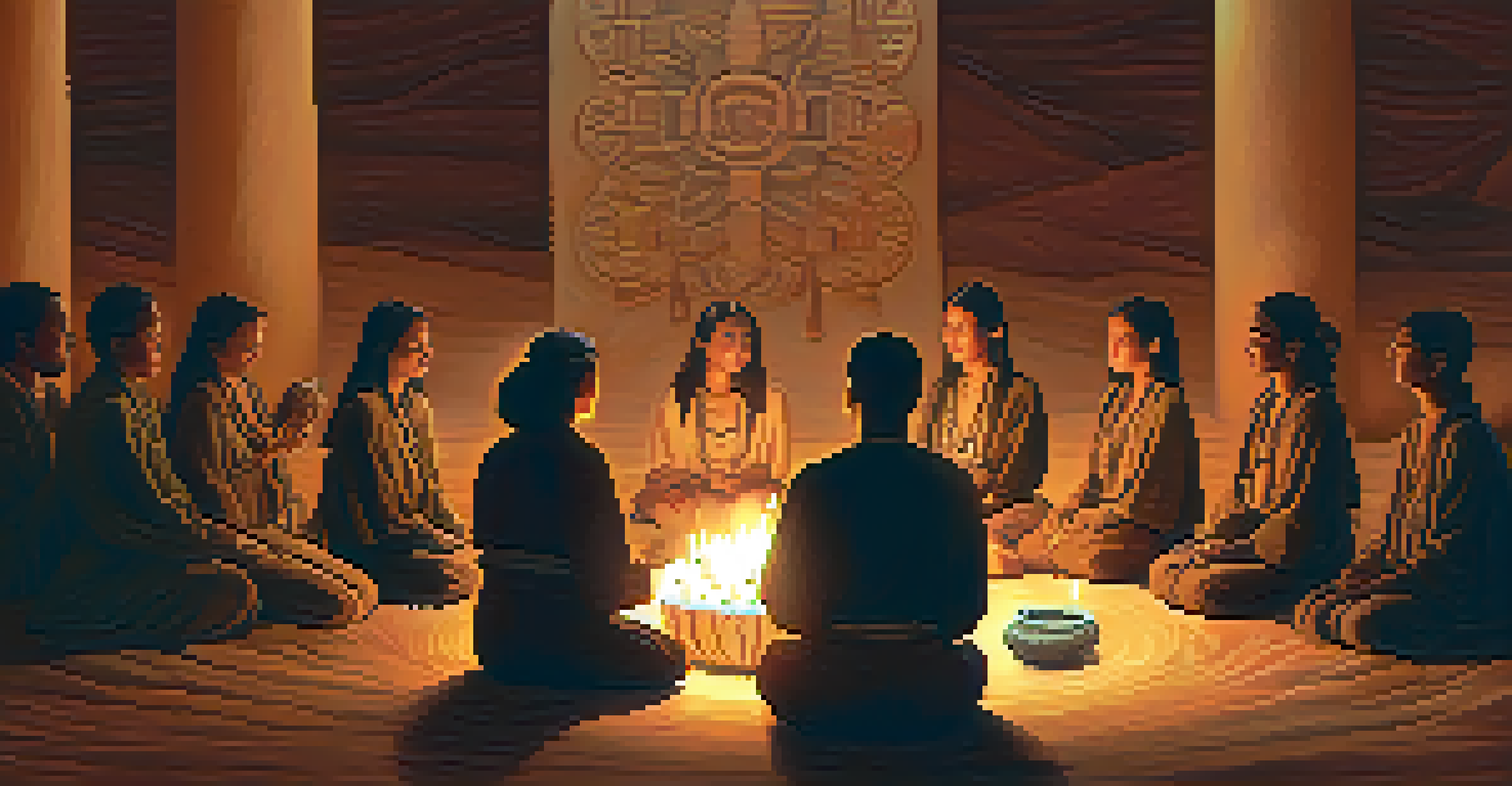Peyote and the Concept of Rebirth in Spiritual Traditions

Understanding Peyote: A Sacred Cactus in Spirituality
Peyote, a small cactus native to Mexico and the southwestern United States, has been used for centuries in various spiritual practices. Its psychoactive properties, primarily due to the compound mescaline, have made it a central element in many Indigenous ceremonies. These rituals often emphasize healing, introspection, and connection to the divine, showcasing Peyote's role as a bridge between the physical and spiritual realms.
The plant is a living entity, a teacher that guides us on our journey to self-discovery and healing.
For many Indigenous cultures, Peyote is not just a plant; it's considered a teacher and a sacred entity. When consumed during ceremonies, it facilitates deep spiritual journeys, allowing participants to confront their inner selves and experience a sense of rebirth. This transformative process is often described in terms of visions that can lead to profound insights and personal revelations.
The reverence for Peyote is deeply rooted in traditions that value the cyclical nature of life, much like the cycles of growth and decay seen in nature. By engaging with Peyote, individuals can explore themes of death and rebirth, symbolizing the shedding of old identities and the emergence of new understandings about themselves and their place in the universe.
The Concept of Rebirth in Various Spiritual Traditions
Rebirth is a theme that resonates across many spiritual traditions, often representing renewal, transformation, and the cyclical nature of existence. In Hinduism, for instance, the idea of reincarnation emphasizes that the soul undergoes a continuous cycle of birth, death, and rebirth, evolving through various life experiences. This journey is seen as a path toward ultimate liberation and enlightenment.

Similarly, in Buddhism, the concept of samsara describes the cycle of birth, life, death, and rebirth, where one's actions (karma) in life determine their future existences. The goal is to break free from this cycle through enlightenment, highlighting the transformative potential of spiritual practice. Such ideas echo the experiences reported by those who partake in Peyote ceremonies, where participants often feel a profound sense of renewal.
Peyote as a Spiritual Teacher
Peyote serves as a sacred entity in Indigenous cultures, facilitating deep spiritual journeys and personal transformation.
These traditions illustrate that rebirth is not merely a physical phenomenon but an inner awakening that can lead to a deeper understanding of one's purpose. In this regard, Peyote serves as a catalyst for such transformations, encouraging individuals to confront their past, embrace change, and embark on a new path filled with clarity and purpose.
Psychoactive Experiences: Insights from Peyote Use
The psychoactive effects of Peyote can lead to intense experiences that often feel like a rebirth. Participants frequently report vivid visual and auditory hallucinations, which can evoke feelings of interconnectedness with the universe. These experiences can act as a mirror, reflecting one’s inner fears, desires, and unresolved issues, prompting personal growth and healing.
In every moment, we are given the opportunity to let go of the past and embrace the new, much like the cycles of nature.
During Peyote ceremonies, individuals may encounter symbolic imagery that represents their emotional and spiritual state. For example, visions of nature, animals, or ancestors can convey messages about one's life journey, urging them to let go of past traumas and embrace new beginnings. This transformative process aligns with the broader concept of rebirth, as it encourages shedding old layers to reveal a more authentic self.
Moreover, the communal aspect of Peyote ceremonies fosters a sense of belonging and shared experience, further enhancing the feeling of rebirth. As participants support one another through their journeys, they cultivate a collective understanding of life's cyclical nature, reinforcing the idea that transformation is a universal experience.
Cultural Significance of Peyote in Indigenous Practices
Peyote has played a vital role in the spiritual practices of Indigenous cultures, particularly among Native American tribes. For many, it is more than a substance; it is a sacred medicine that connects them to their ancestors and the earth. This cultural significance imbues Peyote ceremonies with deep meaning, reflecting a commitment to preserving traditions and fostering spiritual growth.
The integration of Peyote into spiritual practices serves as a reminder of the importance of nature in healing and transformation. Indigenous peoples view the natural world as a living entity, and engaging with Peyote is an expression of respect and gratitude for its gifts. This relationship emphasizes the interconnectedness of all life, highlighting that rebirth is not just an individual experience but a communal journey.
Rebirth Across Spiritual Traditions
The concept of rebirth is prominent in various spiritual practices, symbolizing renewal and the cyclical nature of existence.
Through storytelling, songs, and rituals, Indigenous cultures pass down the wisdom surrounding Peyote and its role in personal and collective rebirth. These teachings not only honor the plant but also affirm the continuous cycle of life, death, and renewal that defines the human experience.
Modern Spirituality and the Resurgence of Peyote Use
In recent years, there has been a resurgence of interest in Peyote and its spiritual properties, particularly among those seeking alternative paths to healing and self-discovery. As more individuals turn to plant medicine, Peyote has found its place in modern spiritual practices, often viewed as a tool for personal transformation and enlightenment. This trend reflects a growing recognition of the value of indigenous wisdom in contemporary society.
Many modern practitioners report profound experiences of rebirth and self-realization through Peyote ceremonies, seeing it as a way to reconnect with their spirituality. These journeys often encourage participants to explore their own beliefs, challenge societal norms, and foster a deeper understanding of their existence. The growing popularity of Peyote underscores the universal desire for transformation and meaning in life.
However, this newfound interest also raises important questions about cultural appropriation and the ethical use of sacred plants. It's crucial for modern practitioners to approach Peyote with respect and awareness of its cultural significance, ensuring that the practices honor Indigenous traditions and support their ongoing preservation.
The Therapeutic Potential of Peyote in Healing Practices
Beyond spiritual rebirth, Peyote shows promise in therapeutic settings, particularly for mental health issues such as depression, anxiety, and PTSD. Some studies suggest that the psychoactive effects of Peyote can facilitate emotional healing by allowing individuals to confront difficult emotions and traumas. This healing process aligns with the broader understanding of rebirth as a form of renewal and recovery.
Therapeutic sessions involving Peyote often emphasize creating a safe and supportive environment, allowing participants to explore their emotions and experiences freely. The insights gained during these sessions can lead to significant shifts in perspective, promoting resilience and personal growth. This therapeutic aspect affirms the idea that rebirth can occur not only in spiritual contexts but also in psychological healing.
Peyote's Therapeutic Potential
Peyote shows promise in therapeutic settings, aiding emotional healing and promoting resilience in mental health.
As the conversation around mental health evolves, integrating plant-based therapies like Peyote into treatment options offers new avenues for healing. This approach emphasizes a holistic understanding of well-being, recognizing that physical, emotional, and spiritual aspects of life are interconnected, much like the themes of rebirth across various traditions.
Conclusion: Embracing Rebirth Through Peyote Experiences
The exploration of Peyote and its connection to the concept of rebirth reveals profound insights into the human experience. From ancient traditions to modern practices, Peyote serves as a powerful symbol of transformation, healing, and the cyclical nature of life. Through its use, individuals are offered a unique opportunity to embark on personal journeys of self-discovery and renewal.
As we reflect on the significance of rebirth across spiritual traditions, it becomes clear that this theme transcends time and culture. Whether through the lens of Indigenous practices or modern therapeutic settings, the journey of rebirth invites us to confront our past, embrace change, and cultivate a deeper understanding of ourselves and our place in the world.

In a world that often feels fast-paced and disconnected, the lessons from Peyote remind us to honor the cycles of life, death, and rebirth. By engaging with this sacred plant, we can tap into ancient wisdom that encourages not only personal transformation but also a collective awakening to the interconnectedness of all beings.